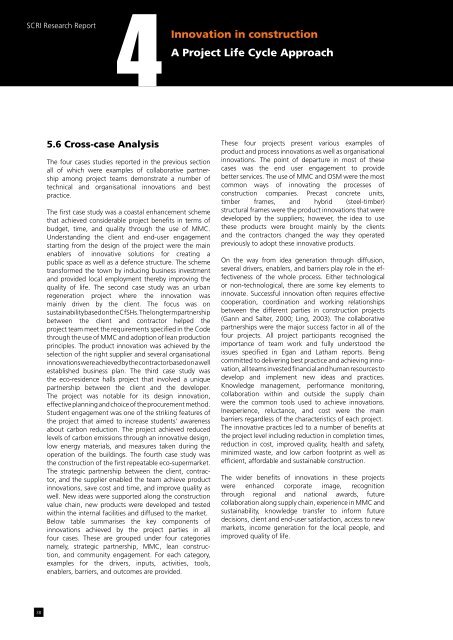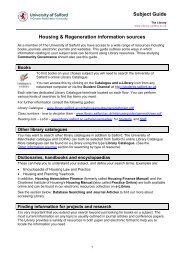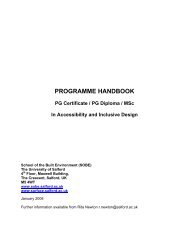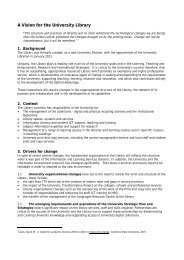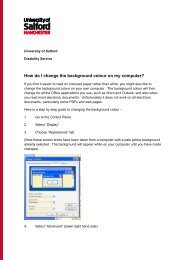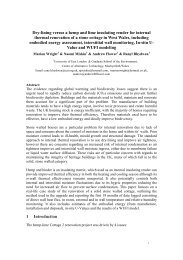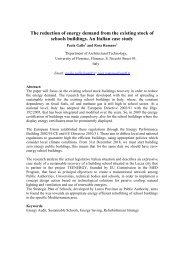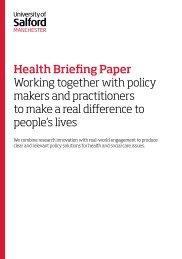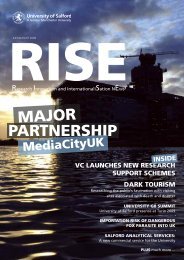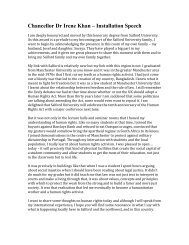Innovation in Construction A Project Life Cycle Approach
Innovation in Construction A Project Life Cycle Approach
Innovation in Construction A Project Life Cycle Approach
Create successful ePaper yourself
Turn your PDF publications into a flip-book with our unique Google optimized e-Paper software.
SCRI Research Report4<strong>Innovation</strong> <strong>in</strong> constructionA <strong>Project</strong> <strong>Life</strong> <strong>Cycle</strong> <strong>Approach</strong>5.6 Cross-case AnalysisThe four cases studies reported <strong>in</strong> the previous sectionall of which were examples of collaborative partnershipamong project teams demonstrate a number oftechnical and organisational <strong>in</strong>novations and bestpractice.The first case study was a coastal enhancement schemethat achieved considerable project benefits <strong>in</strong> terms ofbudget, time, and quality through the use of MMC.Understand<strong>in</strong>g the client and end-user engagementstart<strong>in</strong>g from the design of the project were the ma<strong>in</strong>enablers of <strong>in</strong>novative solutions for creat<strong>in</strong>g apublic space as well as a defence structure. The schemetransformed the town by <strong>in</strong>duc<strong>in</strong>g bus<strong>in</strong>ess <strong>in</strong>vestmentand provided local employment thereby improv<strong>in</strong>g thequality of life. The second case study was an urbanregeneration project where the <strong>in</strong>novation wasma<strong>in</strong>ly driven by the client. The focus was onsusta<strong>in</strong>ability based on the CfSHs. The long term partnershipbetween the client and contractor helped theproject team meet the requirements specified <strong>in</strong> the Codethrough the use of MMC and adoption of lean productionpr<strong>in</strong>ciples. The product <strong>in</strong>novation was achieved by theselection of the right supplier and several organisational<strong>in</strong>novations were achieved by the contractor based on a wellestablished bus<strong>in</strong>ess plan. The third case study wasthe eco-residence halls project that <strong>in</strong>volved a uniquepartnership between the client and the developer.The project was notable for its design <strong>in</strong>novation,effective plann<strong>in</strong>g and choice of the procurement method.Student engagement was one of the strik<strong>in</strong>g features ofthe project that aimed to <strong>in</strong>crease students’ awarenessabout carbon reduction. The project achieved reducedlevels of carbon emissions through an <strong>in</strong>novative design,low energy materials, and measures taken dur<strong>in</strong>g theoperation of the build<strong>in</strong>gs. The fourth case study wasthe construction of the first repeatable eco-supermarket.The strategic partnership between the client, contractor,and the supplier enabled the team achieve product<strong>in</strong>novations, save cost and time, and improve quality aswell. New ideas were supported along the constructionvalue cha<strong>in</strong>, new products were developed and testedwith<strong>in</strong> the <strong>in</strong>ternal facilities and diffused to the market.Below table summarises the key components of<strong>in</strong>novations achieved by the project parties <strong>in</strong> allfour cases. These are grouped under four categoriesnamely, strategic partnership, MMC, lean construction,and community engagement. For each category,examples for the drivers, <strong>in</strong>puts, activities, tools,enablers, barriers, and outcomes are provided.These four projects present various examples ofproduct and process <strong>in</strong>novations as well as organisational<strong>in</strong>novations. The po<strong>in</strong>t of departure <strong>in</strong> most of thesecases was the end user engagement to providebetter services. The use of MMC and OSM were the mostcommon ways of <strong>in</strong>novat<strong>in</strong>g the processes ofconstruction companies. Precast concrete units,timber frames, and hybrid (steel-timber)structural frames were the product <strong>in</strong>novations that weredeveloped by the suppliers; however, the idea to usethese products were brought ma<strong>in</strong>ly by the clientsand the contractors changed the way they operatedpreviously to adopt these <strong>in</strong>novative products.On the way from idea generation through diffusion,several drivers, enablers, and barriers play role <strong>in</strong> the effectivenessof the whole process. Either technologicalor non-technological, there are some key elements to<strong>in</strong>novate. Successful <strong>in</strong>novation often requires effectivecooperation, coord<strong>in</strong>ation and work<strong>in</strong>g relationshipsbetween the different parties <strong>in</strong> construction projects(Gann and Salter, 2000; L<strong>in</strong>g, 2003). The collaborativepartnerships were the major success factor <strong>in</strong> all of thefour projects. All project participants recognised theimportance of team work and fully understood theissues specified <strong>in</strong> Egan and Latham reports. Be<strong>in</strong>gcommitted to deliver<strong>in</strong>g best practice and achiev<strong>in</strong>g <strong>in</strong>novation,all teams <strong>in</strong>vested f<strong>in</strong>ancial and human resources todevelop and implement new ideas and practices.Knowledge management, performance monitor<strong>in</strong>g,collaboration with<strong>in</strong> and outside the supply cha<strong>in</strong>were the common tools used to achieve <strong>in</strong>novations.Inexperience, reluctance, and cost were the ma<strong>in</strong>barriers regardless of the characteristics of each project.The <strong>in</strong>novative practices led to a number of benefits atthe project level <strong>in</strong>clud<strong>in</strong>g reduction <strong>in</strong> completion times,reduction <strong>in</strong> cost, improved quality, health and safety,m<strong>in</strong>imized waste, and low carbon footpr<strong>in</strong>t as well asefficient, affordable and susta<strong>in</strong>able construction.The wider benefits of <strong>in</strong>novations <strong>in</strong> these projectswere enhanced corporate image, recognitionthrough regional and national awards, futurecollaboration along supply cha<strong>in</strong>, experience <strong>in</strong> MMC andsusta<strong>in</strong>ability, knowledge transfer to <strong>in</strong>form futuredecisions, client and end-user satisfaction, access to newmarkets, <strong>in</strong>come generation for the local people, andimproved quality of life.38


